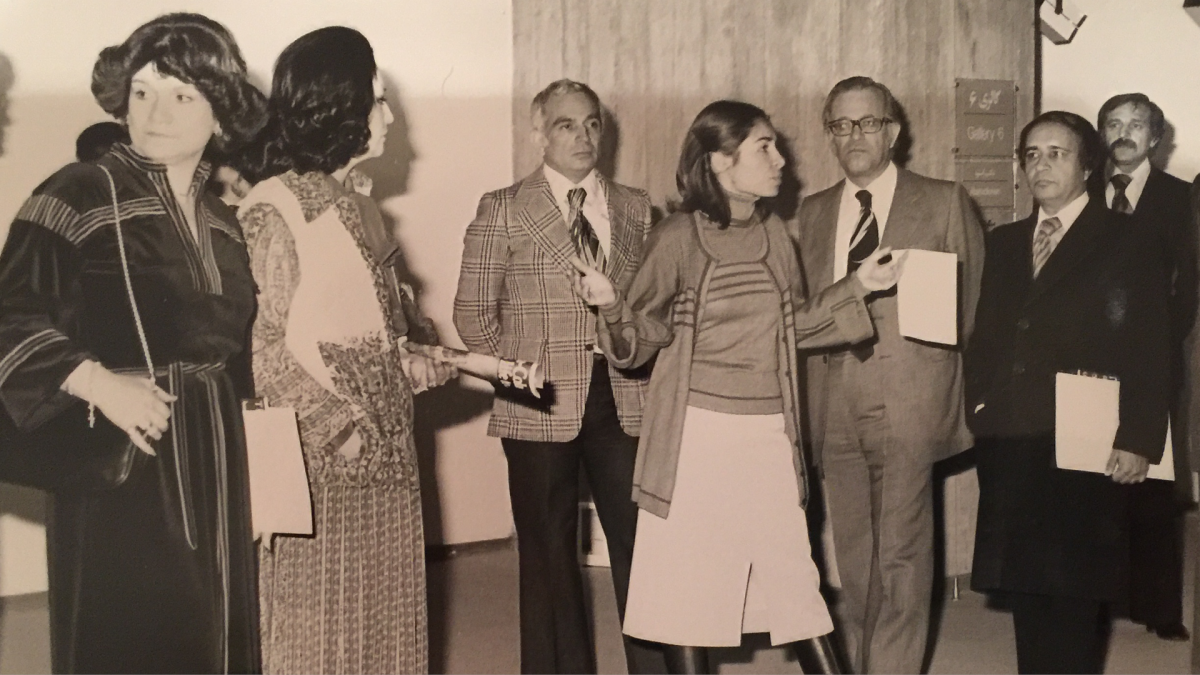
Roxane Zand: Remembering Tehran
Sotheby’s Deputy Chairman Roxane Zand goes back in time to when she resided in Tehran during the 1970s, playing a pivotal role in the development of the Iranian art and culture scene
Tehran in the 1970s was a time of heady artistic and cultural growth. Unsurprisingly, this was connected to two main factors: an oil-fuelled economy and the supportive and enthusiastic Empress Farah Diba. Already in the late 1960s, intellectual circles and artistic innovations by a handful of modern masters, who later came to be known as the ‘Saqqa Khaneh’ group, were pushing boundaries and coming away from the miniaturist traditions strongly taught in the Dar al Funun. The new idea of anthropology and the writings of Iraj Afshar veered cultural perspectives towards folklore and indigenous motifs as valid subjects of exploration. The enlightened circles were small, writers and artists knew each other and would often interact—though not as cohesively as with the Bauhaus movement, for example. Neighbouring populist cultures such as Bollywood cinema (pervasive in Iran) or the prominence of Egypt as a key regional figure, subtly influenced thinking and evolution. Artists travelled more frequently abroad—as far afield as Japan, USA, Italy and Paris. These exposures meant a new artistic climate.

Roxane Zand restores a Derain painting. Circa 1970s
By the early 1970s, plans were afoot for major museum development, spearheaded by the passion of the Empress. The Carpet Museum, Negaristan Museum, Niavaran Cultural Centre and the now well-known Tehran Museum of Contemporary Art, all opened or became dynamically active within a few years of each other. Mrs Naz Diba, cousin of the Empress, headed the Carpet Museum that was built in close proximity to TMOCA, in turn designed and headed by her architect brother Kamran Diba. The Negaristan Museum was directed by Dr Layla Diba, and the Niavaran Cultural Centre by the late Firouz Shirvanloo. It was a time of rapid change and exciting experimentation—some of which felt premature or ahead of its time. This too was occasionally the sentiment with the extraordinary Shiraz Arts Festival. A series of art events, performances, workshops, films, and shows that rivalled anything produced in the West, and that exposed the Iranian populace to what was happening in the rest of the world. While the newly formed country of the United Arab Emirates (1971) was also committed to an art programme in the Emirate of Sharjah, it is often ignored that the first regional Biennale happened in Tehran as early as 1958. There was a clear sense of cultural ‘pioneering’, and adventurousness in what could be accomplished. Assyrian artist Hannibal Alkhas and his generation created a sense of possibility and cross-fertilisation: Armenian, Turkic, Southern, and Assyrian artists expressed themselves as Iranians first and foremost—in a country that has historically struggled with a tribal and ethnically-diverse population. Avant-garde artists of the 1970s, the most important of which is the still-active Parviz Tanavoli, optimised this new sense of possibility by exploring and showcasing indigenous motifs and local heritage. It became trendy to show a local ‘adobe-like’ landscape by artist Mohamed Radvand, while Monir Farmanfarmaian delved into the mirror-mosaics of shrines.

Roxane Zand conducts an interview
Freshly graduated from Harvard and after a few years at UNESCO, I was encouraged to return to Iran to play more of a role in this dynamic environment. As a gallery hand for Homa Zand in her eponymous gallery, which was a first of its kind (showing avant-garde Western art), I came to know the various artists that she and her business partner Fereydoun Ave represented. The Empress would attend some of the openings, and her personal attention drove home the importance of this aspect of life. Amongst the educated elite, an interest in art and culture became pervasive. But before too long, the Tehran Museum of Contemporary Art needed skilled staff. Kamran Diba invited me to join him as the first employee in what was then a hardhat area, and within a year, the museum became ready for opening with a chief curator in the person of David Galloway, and American Judson Chrisney on the managerial side. We worked tirelessly around the clock to meet the launch deadline, and both His Majesty and the Empress paid unannounced inspection visits. The opening itself was second only to the glamour and importance of the 2,500 Year Celebrations in 1971. Dignitaries, art critics, artists and dealers from around the world attended the unveiling of what was undoubtedly the most progressive regional institution.
Meanwhile, parallel activities were happening at the Niavaran Cultural Centre where the focus was on publications. A major bi-lingual volume entitled The Avesta was published under its auspices, and well-known artist Massoud Arabshahi was commissioned to produce a large number of landmark illustrations. I was asked to do the translation, but years later when I tried to obtain a volume to gift to a library, I discovered that many copies had been destroyed, as they were not Islamic texts. Other important, award-winning publications for a young readership such as Little Black Fish appeared through the output of Kanoon-e Parvaresh Fekri-e Kudakan, many of which were under the supervision of the Empress’s office. Even the Iranian Radio and Television service, led by Reza Ghotbi, proactively promoted the appreciation of music—both Western and Iranian—performance, theatre, film, and so on, generating a rich cultural output that came to receive homage in a major 2014 show at the Paris Museum of Modern Art under the title of Iran:Unedited History.
Iran’s story of cultural and artistic evolution continues to be written. The next exciting chapter is still to come, and the world looks forward with anticipation and hope.
Read Roxane’s blog Cultural Crossroads on the arts of the Middle East and North Africa.
This article originally appears in the Summer 2016 issue of Harper’s Bazaar Art. The 2,500 year celebrations of the Persian Empire were erroneously stated as the 25,000 year celebrations.
